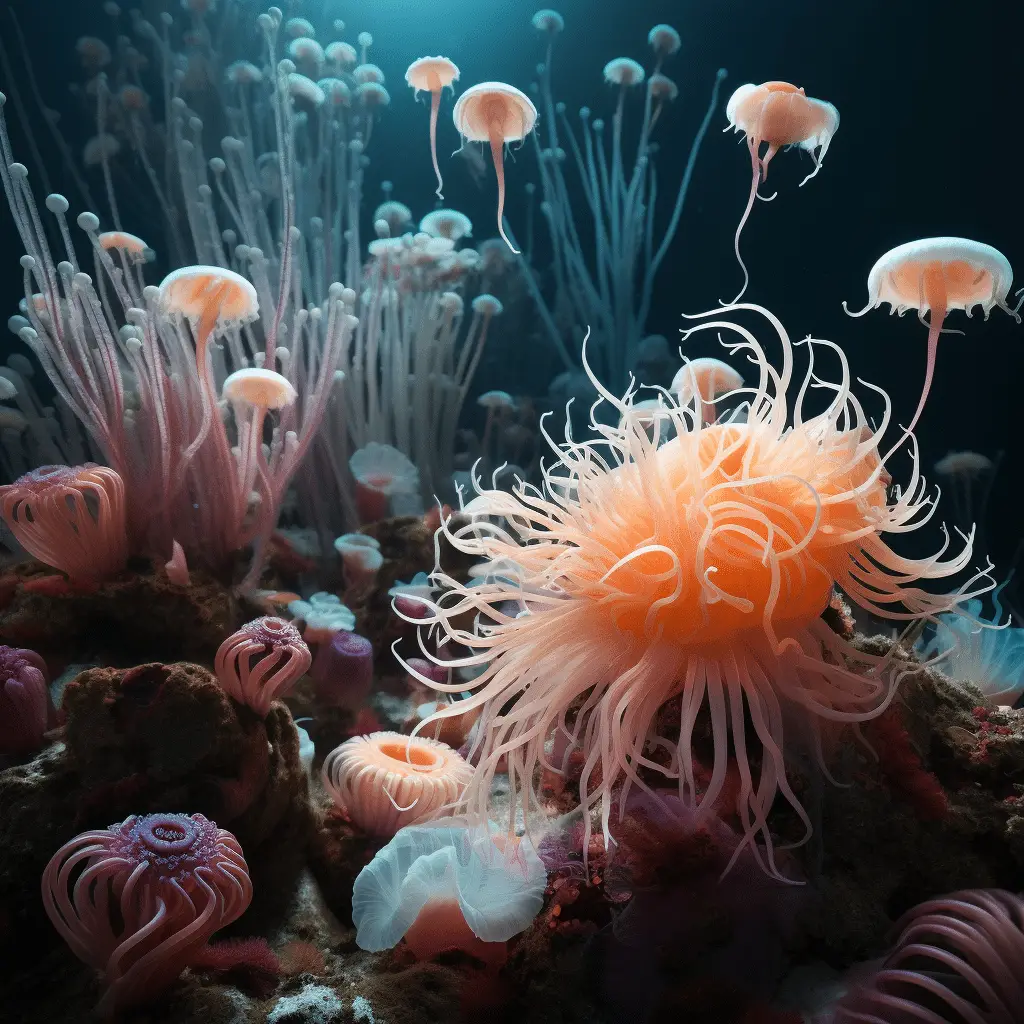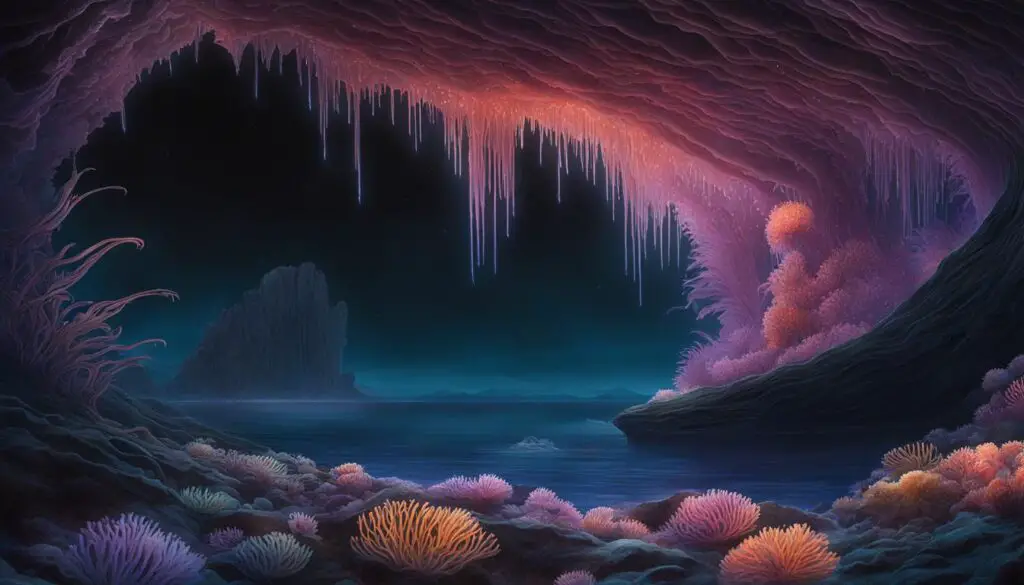Deep Sea Anemones: Marvels Of Extreme Ocean Adaptations

Deep sea anemones are fascinating creatures that inhabit the depths of the ocean. They have adapted to survive in extreme conditions and have unique characteristics that make them marvels of the deep Pacific Ocean. There are various types of deep sea anemones with different adaptations and habitats. Exploring the diversity and ecology of these species is crucial for understanding the delicate balance of the deep-sea ecosystem.
Key Takeaways:
- Exceptional in every way, deep sea anemones are a thriving part of the marine ecosystem.
- They’re able to endure harsh environments because they’ve adapted to things like low temperatures, high pressure, and darkness.
- Different varieties of anemones in the deep water have developed specialized structures and behaviors.
- Understanding the deep-sea ecosystem requires research into the variety and ecology of deep-sea anemones.
- Protecting these species and keeping the deep sea’s biodiversity intact depends critically on conservation initiatives.Our expanding understanding of the environments in which deep sea anemones thrive has brought into sharp focus the need of conserving these delicate creatures. Protecting deep-sea anemones and their habitats is crucial to preserving the biodiversity of the ocean for future generations.
Deep Sea Anemone Habitats and Adaptations

Once upon a time, in the depths of the ocean, there lived a group of enchanting creatures known as deep sea anemones. These colorful and delicate beings were marvels of the deep, with their tentacles waving gracefully in the currents.
But life in the deep sea was no easy feat. These resilient anemones had to adapt to survive in some of the harshest environments on Earth. Despite the extreme conditions, the deep sea anemones thrived, thanks to their incredible adaptations. They had developed specialized proteins that allowed them to maintain their cell structure and function in complete darkness and under intense pressure.
Some even formed symbiotic relationships with shrimp and crabs, who offered protection and food in exchange for the anemones’ shelter.
As the ocean currents and geology shifted, so did the distribution of these magical creatures. And so, the deep sea anemones continued to dance and sway in the currents, a stunning reminder of the wonders that lay beneath the surface of the ocean.
Table: Distribution of Deep Sea Anemones
| Region | Deep Sea Anemone Species |
|---|---|
| Atlantic Ocean | Heteractis magnifica, Cerianthidae, Cribrinopsis fernaldi |
| Pacific Ocean | Boloceroides mcmurrichi, Phymanthus crucifer, Actinostola chirolophora |
| Indian Ocean | Amphianthus dohrnii, Entacmaea quadricolor, Macrodactyla doreensis |
“Deep sea anemones are remarkable examples of adaptation and resilience. Despite the extreme conditions of their habitats, they have managed to thrive and play a vital role in the deep-sea ecosystem. Studying their unique adaptations and distribution patterns is essential for understanding the intricate web of life in the depths of our oceans.” – Dr. Jane Mitchell, Marine Biologist
Our growing knowledge of deep sea anemone habitats and adaptations emphasizes the need to protect these vulnerable organisms. Maintaining the richness of the deep-sea environment depends on protecting anemones and their habitats for future generations.
Studying Deep Sea Anemones for Conservation

Understanding the intricacies of deep sea anemones is crucial for their conservation and the overall health of the deep-sea ecosystem. These remarkable creatures face numerous threats from human activities, including deep-sea mining, pollution, and climate change. To protect these vulnerable species, we must delve into their ecology, distribution, and adaptations.
Researchers are essential to discovering deep-sea anemones’ hidden wonders. Woods Hole Oceanographic Institution and NOAA Office of Ocean Exploration and Research lead such studies. We can create effective conservation strategies to protect these amazing species by working together and sharing knowledge.
Deep sea anemone research helps conserve these amazing creatures and preserve the deep-sea ecosystem’s biodiversity. Every discovery and insight from research helps us understand the delicate balance that sustains ocean life. Awareness of deep-sea anemones and their conservation needs can inspire action and a collective commitment to protect these fragile habitats.
Research and conservation are needed for deep sea anemones. We must work hard to preserve these fascinating species and add to the ocean’s complex life.
FAQ
What are deep sea anemones?
Deep sea anemones are fascinating creatures that inhabit the depths of the ocean. They have unique adaptations to survive in extreme conditions and are crucial for the deep-sea ecosystem.
Where can deep sea anemones be found?
Deep sea anemones can be found in habitats such as hydrothermal vents, cold seeps, and deep-sea coral reefs. These habitats provide the necessary conditions for their survival.
How do deep sea anemones adapt to their environment?
Deep sea anemones have evolved specialized adaptations to withstand the high pressure, low temperatures, and lack of sunlight in deep-sea environments. These adaptations include specialized proteins, efficient feeding mechanisms, and symbiotic relationships.
Why is studying deep sea anemones important?
Studying deep sea anemones is crucial for their conservation and the overall health of the deep-sea ecosystem. Understanding their ecology, distribution, and adaptations helps develop effective conservation strategies.
What threats do deep sea anemones face?
Deep sea anemones are threatened by human activities such as deep-sea mining, pollution, and climate change. Conservation efforts are essential to protect these vulnerable species.
How can research expeditions help uncover the marvels of deep-sea anemones?
Research expeditions conducted by organizations such as the Woods Hole Oceanographic Institution and the NOAA Office of Ocean Exploration and Research play a vital role in uncovering the unseen marvels of deep-sea anemones and raising awareness about their importance.
How can we ensure the long-term survival of deep sea anemones?
Ongoing studies and conservation efforts are necessary to ensure the long-term survival of deep sea anemones and maintain the biodiversity of the deep-sea ecosystem.



